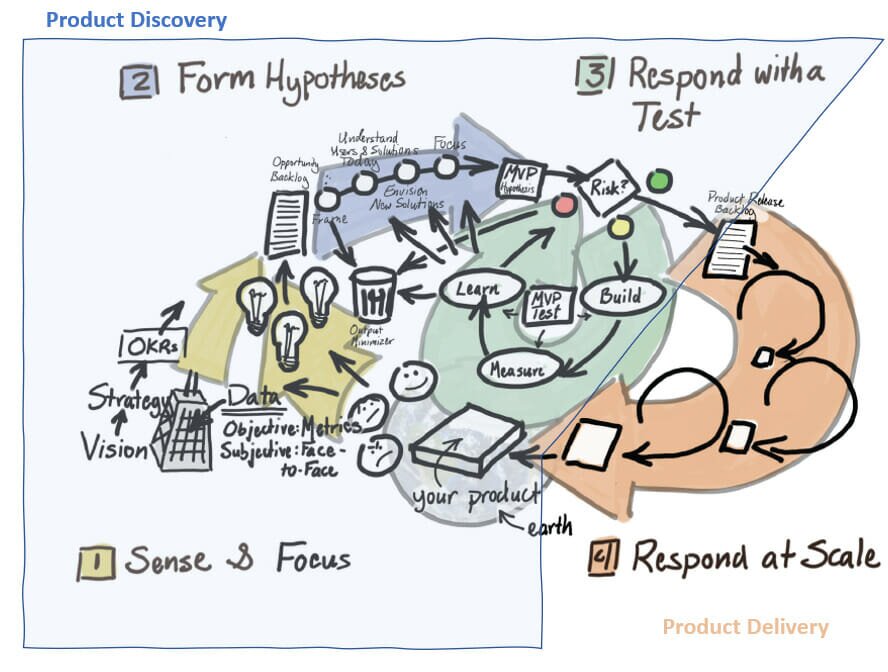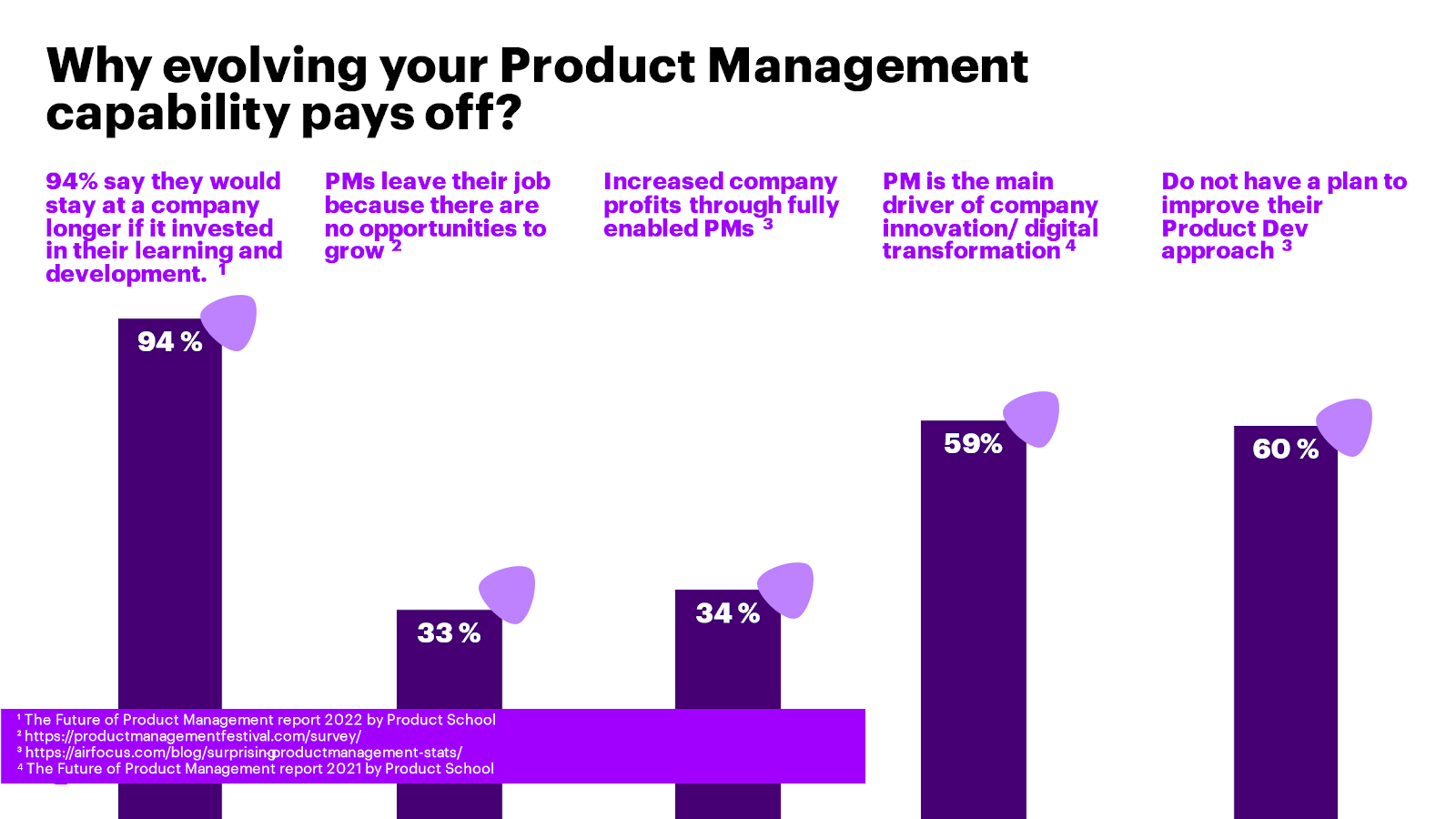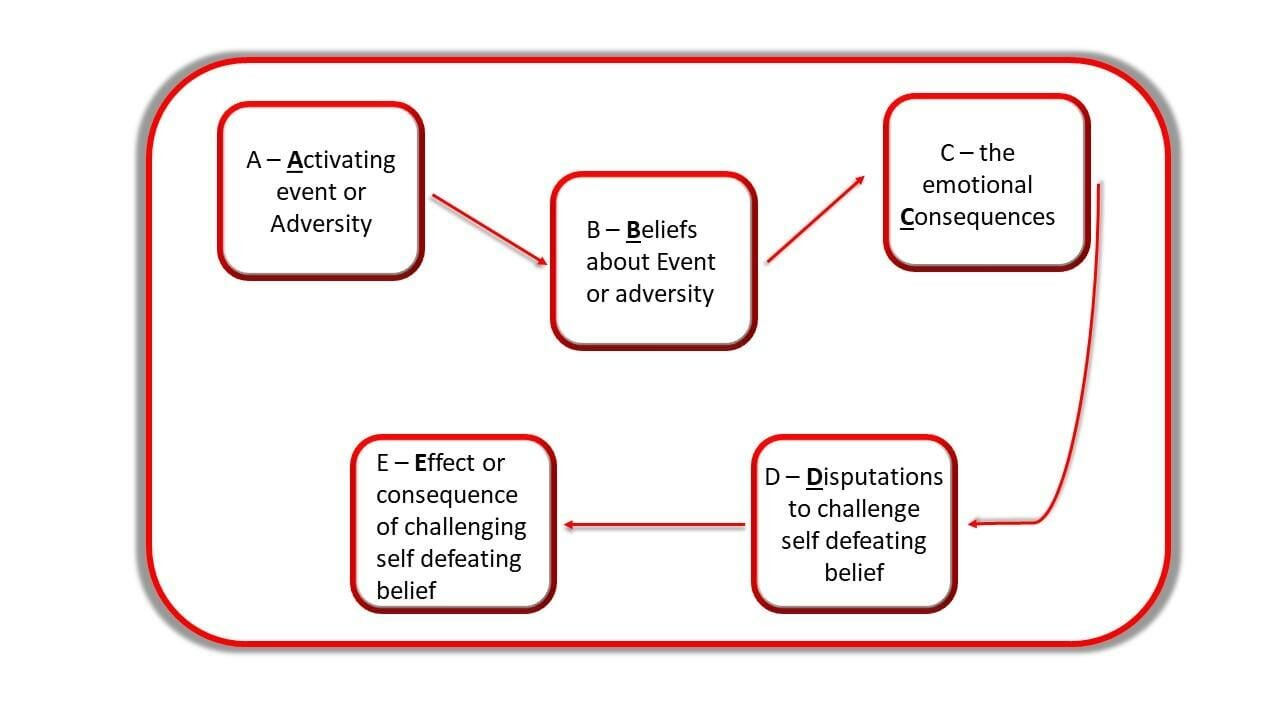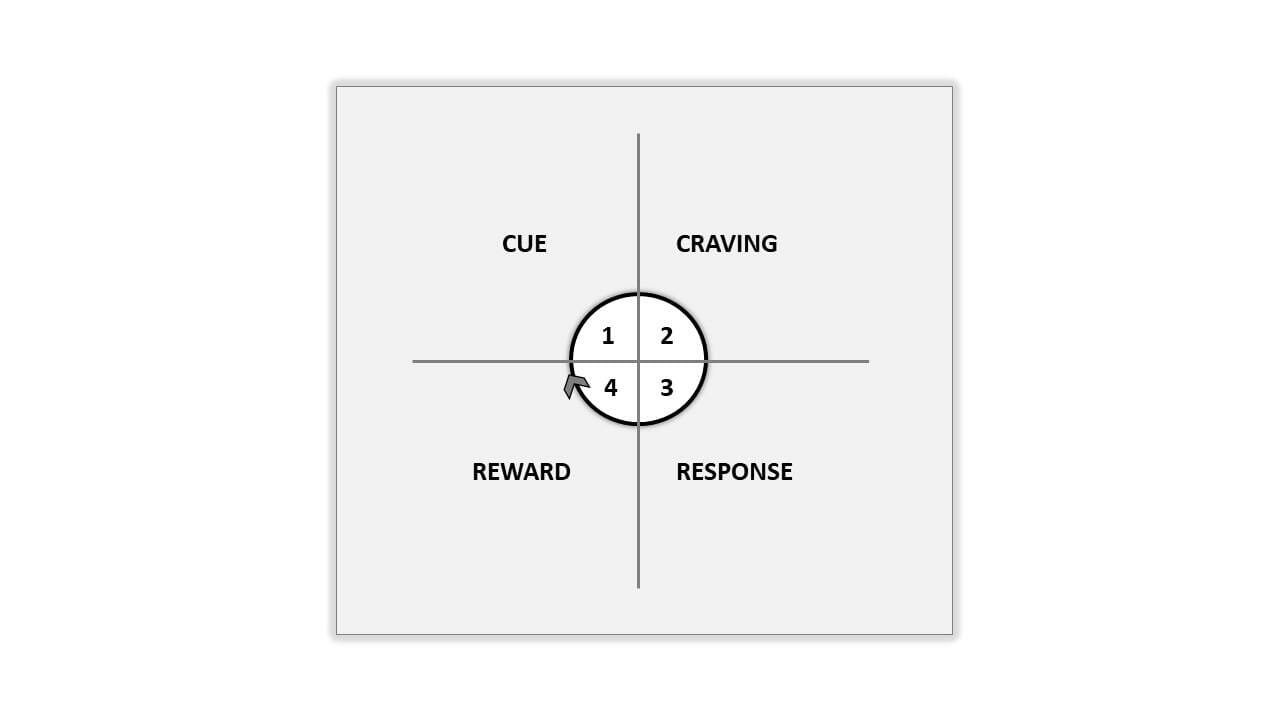This article is inspired by Teresa Torres and her book “Continuous Discovery Habits” (2021), which contains numerous valuable methods and experience how product discovery can work and when you apply it.
In contrary to the book, this article focuses explicitly on what organizations and product leads can do to establish discovery habits (knowing that creating a new habit is hard to achieve):
Combining social, psychological and product discovery knowhow, we found these two approaches to be promising to establish product discovery habits or routines in your organization:
- Coaching Product Discovery ABCDE Model
- Replace an old habit with a new one
The suggested mechanisms can also be used for other areas of work such as technical excellence or agile way of working.
What is product discovery all about, and why does it even matter?
Authors such as Marty Cagan, Theresa Torres, John Cuttler, and many more stated their definition of Product Discovery in various books, articles, and social media. Here is our own summary of what Product Discovery is:
Marty Cagan describes these risks as:
- Value risk: whether customers will buy it, or users will choose to use it.
- Usability risk: whether users can figure out how to use it.
- Feasibility risk: whether our engineers can build what we need with the time, skills, and technology we have.
- Business viability risk: whether this solution also works for the various aspects of our business.
To see product discovery in the broader product development environment it helps to look at Jeff Patton’s product development cycle (Patton 2019: 9) . With the blue overlay provided, the difference between product discovery and product delivery can be made very explicit (to be very precise product vision and strategy is included in the blue overlay as well, but technically does not belong to product discovery).

Now, let us have a look at why product discovery and product management matter:

Often change agents or product managers realize the problem of missing product discovery processes and they start to implement discovery activities in product teams. Value add is recognized very quickly, but when returning after a few months or years, these product teams can often be found not doing most of the activities anymore. Due to vastly varied reasons, these activities never reached the status of a routine or even a habit and thus, people stop doing them after some time.
What is a habit, and how do we create one?
Habits are actions/behaviors we do on a regular basis; we do not have to think about them, and we do them automatically or unintentionally (Duhigg 2012). We all have multiple habits, and in sum, they make us the people we are today. Habits can either be destructive as biting your fingernails when you are nervous, beneficial, and irreplaceable as brushing your teeth, or productive as going for a run when you are stressed.
Learning a new habit can be a hard challenge, as most people probably can relate to. Especially around New Year’s Eve time, when people reflect on the previous year and want to make changes to their life.
Let us break down the process of habit formation to get a better understanding of what habits are and how they unfold. A habit consists of four building blocks/stage as presented in figure 3. It is according to Clear (2018) an ongoing cycle of these four stages that is a neurological feedback loop – which is the habit loop.
“This four-step pattern is the backbone of every habit, and your brain runs through these steps in the same order each time.” (Clear 2016:47)
Figure 3: The four stages of habit after James Clear, 2018, p.50
| Habit component | Description of habit |
| CUE | Trigger for action in our brain. |
| CRAVING | It is the motivation that shows then e.g., switching on the radio to listen to music -> motivation is not to listen to music – it is rather being entertained, not being alone etc. |
| RESPONSE | Consequent response one is practicing after the cycle started with the cue: It is the habit -> feeling ease listening to music |
| REWARD | The fourth and last step of the loop which creates satisfaction and increases knowledge; It is what the brain understands – feeling in company |
Table 1: Description of habit loop components after Clear, 2018
Habits should not only be seen on their own. Usually, we can identify habit loops that can either be “beneficial” or “self-destructive”. Sticking with the example above, the following example is provided for a “destructive” habit loop. While scrolling on Instagram a person might choose to eat some chips. Eating chips once while scrolling on Instagram will not have a major negative effect on anybody. However, doing it regularly or even daily will have major effects on a person. A consequence of repeating this habit loop could be that the person would gain weight, therefore, the act of doing sport would get more difficult, and his/her self-esteem could decrease. Since the person is doing less sport, he/she has more time available to scroll on Instagram and eat chips. Resulting in a self-fulfilling prophecy. The habit loop gets stronger over time, and it gets more difficult to break the established habit loop.
But how long does it take to form a new habit?
Within the habit research literature, different findings are available about how long it takes to build a habit, it can range anywhere from a minimum of 21 days (amazon.de, Maltz 1989) and up to 66 days (jamesclear.com 16.06.2023) to establish a habit in one’s life. The number of days is dependent on the respective person and the habit itself, either way it will take willpower and willpower to establish the desired habit.
How can we build a new desired habit in our life?
According to James Clear, author of the book Atomic Habits, we can use the four universal laws of habit formation to implement new habits in our lives. To make the four laws more concrete, they are applied to the habit of meditating.
Make the habit obvious. It is much easier for us to do something if we are constantly reminded of it. Instead of meditating at a nonspecific area in your flat, we could specify a dedicated area for meditating and highlight it by buying a mediation pillar for it. Every time we see this area, our brain would be reminded of the meditation habit we would like to establish.
Make the habit more attractive. A habit can take up many different forms. It does not mean that you need to do the same habit as another person recommends it to you. Instead of doing a meditation in silence, it could be easier for you to do it while having headphones on and listening to nature sounds or other background music you prefer. In case you dislike sitting, it could be an idea to try out a walking meditation practice.
Make the habit easier. While meditating every day for half an hour sounds beneficial, it makes the habit formation process more complicated. Instead of having the goal of meditating for half an hour, you could first try to meditate for one minute each day until the habit sticks. It is much easier to adjust an already established habit instead of reaching for the end goal at the beginning, “mastering the art of showing up”.
Make the habit satisfying. Rewarding yourself after sticking to your habit, makes your brain connect the reward with the new habit. Drinking your favorite hot beverage after sticking to your habit, makes it easier for you to stick with the habit instead of directly starting to open your laptop and checking E-Mails (Clear 2018:54).
Besides these four universal laws, there is also the option to implement a good habit by replacing it with another good one. Why is that the case? It is easier to replace a bad habit by a new one because we are already triggered by the cue that initiates the old habit, therefore, we do not have to implement a completely new routine in our life but rather adjust the old routine we already have.
Tools to create a powerful habit for product discovery
Coaching product discovery ABCDE Model
There is probably more than one tool to support creating a powerful habit that sticks with one – needless to say, there is also a personal preference to it. In the context of work, a known and proven method is chosen in this chapter to explain how this could work out.
It is immanent to the human being that it likes to stay with learned and proofed, customs and habits. Changing to something new always requires a portion of curiosity, courage and sometimes one feels pain with the present habit and really needs to change. To make this transition more acceptable, the behavioral coaching model ‘ABCDE Model’ can support it as it brings quick results, which motivate the coachee to move on.
The model itself is used in coaching practice to support coachees to move on to their goal and especially support if psychological block(s) exist(s) at the coachee. Neenan (Neenan in Passmore 2016:131) states that ‘…the viewpoint we choose determines our reaction to ‘things’.’
The model is composed of five building blocks that are built on each other (figure 4). Before diving into it with an example and discovering how this can help change habits in product discovery, the basic building blocks are explained.
A-Activating event and Adversity
In this block, the coachee faces and activation event. In coaching, this is the phase when the coachee describes the situation, articulates the most worrying topics. Here the subjective view of the coachee is reflected to the coach.
B-Beliefs about Event or adversity
The coachee here reflects on the existing limitations that he sees around the event. They are self-limiting to the coachee, sometimes irrational and need to be known to solve the problem.
C-The emotional consequences
The consequences of the belief can be all or just single aspects of the following ones:
emotional, behavioral, physical, interpersonal and cognitive. The less we have the easier is the change to a new behavior for the coachee.
D-Disputations to challenge self-defeating belief
There are various characteristics that fall into this building block. They all deal with the tradeoffs that the coachee needs to take into account. This part of the model is for the coachee to evaluate all of these and decide which patterns are given up/changed for the benefit of adopting more supportive ones. It is the re-framing part of the model, and the coach guides the coachee to put the new solution into a from that is in one or more of the C-building block aspects to make it stick in a positive way.
E-Effect or Consequence of challenging self-defeating belief
By arriving in this building block, the coachee now sees the new outlook. This is promising to the coachee and should be supported by the coach to make the new outlook, which is, in the best case, also anchored in the emotions of the coachee, a continuous one.

In a practical way, the model could look like this:
- A – Activating Event: Product Manager learns about a new user problem.
- B – Beliefs: Product Manager feels the urge to propose a solution immediately as he otherwise would be seen as a non-effective expert. (Causes a self-limiting belief = immediate solution).
- C – emotional Consequence: Product Manager pushes this to the team (interpersonal irritation with team) that now has an overloaded work performance and pressure which leads to friction in the team and unrealistic product roadmaps (-> anxious emotions), disappointment when outcome is not reached.
- D – Disputation to self-defeating belief: Product Manager evaluates if the urge for the proposal is really needed and what the trade-offs are. Also looks into other options. In our example this could be that it is not reasonable to enter the solution phase immediately.
- E – Effect: Product Manager now realizes that a reasonable amount of product discovery is valuable to fully understand the user problem and only then the team is able to solve the problem for the future.
Once arrived in building block E it needs to be ensured that the new habit sticks. This can be made happen by using the model of force-field analysis after Lewin & Gold, 1999. All drivers, which support the new habit should be noted. Once this is done the resisting forces are listed. These deal with people, the organization etc. At the end, it is about assessing the drivers and resisters to be always aware to pay attention at the critical ones on the list to not derail from the new habit.
Replace a bad habit with a good one
One possibility to transform product discovery into a habit is to attach the product discovery process to an already established habit loop/routine or replace the old undesired action of a habit by a more satisfying step such as product discovery. By replacing the old undesired action with product discovery, the old routine can remain almost as before, but the action step will be different.
Old Habit Loop:
- Cue – I got a new feature request from the stakeholder
- Craving – I want to be perceived as solution oriented and helpful
- Old action – I respond with a plan to build the feature
- Reward – I built a new feature
New Habit Loop:
- Cue – I got a new feature request from the stakeholder
- Craving – I want to satisfy my users’ needs
- New action – I learn more about the underlying user problem, learn what about their needs (= product discovery)
- Reward – I learned about new insights and thus, was able to build a more powerful solution.
It is important to illustrate the benefits of product discovery to the employees to make product discovery the default action after the initiated cue. If employees realize that it takes less time to create a new innovative product, or ideas can be tested in a faster way employees will be more likely to carry out product discovery than the old undesired action. Leadership can foster the habit change simply by asking frequently for product learnings and insights.
Conclusion
Summarizing the mentioned problem and possible solutions, it can be stated that there are many product management approaches with great potential to help product managers in their daily job. Assuming new approaches are easily adopted as a habit or routine might be a quick pitfall. Creating habits or routines requires action, strategy, and time. Especially, if entire organizations transform from very classical project-oriented business to be product-led. The two mentioned approaches can help people to enter a mindset shift in a structured way:
- Coaching Product Discovery ABCDE Model
- Replace an old habit with a new one








